Bangkok Navaratri Festival: The Celebration of the Goddess Parvati
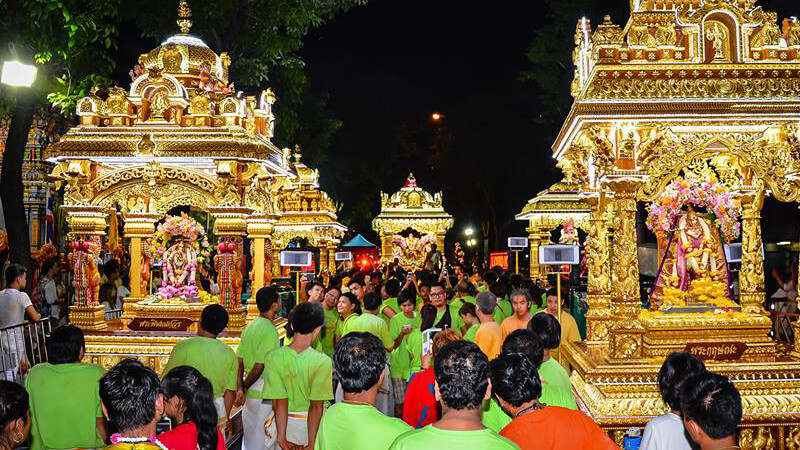
(cr. Thai News)
Navaratri is a celebration during the months of September and October, observed by those who subscribe to the Hindu-Brahman faith. It means “nine nights” in which “nava” means nine and “ratri” means night. This highly anticipated event is celebrated mainly in the Indian Subcontinent. Here in Thailand it is celebrated by groups of faithful Thais, Thai Indians, Thai Chinese, and even tourists. You can witness festivities and rituals at Indian temples across the country, but the most famous of these is the Sri Maha Mariamman Temple on Silom Road in Bangkok.
What is Navaratri?
The Navaratri Festival, or “Dussehra”, also known in a simpler name among the Thais as the “Festival of the Goddess Uma” dates back to the Vedic period, or the Vedic age (1500 to 500 BC), of the ancient Indian civilization. On this auspicious occasion, Hindus will come together to worship the Goddess Parvati, also known as Uma Devi (who is sometimes synchronized with the South-Indian Rain Goddess Mariamman), and her nine avatars for nine days from the 1st to the 9th night of the waxing moon in the 11th lunar month. Hindus believe that Parvati and other deities will descend upon the Earth during this time to bestow blessings upon humanity.
In Bangkok, the most significant moment is on the last day of the festival when the idols of Parvati and other deities are paraded on Silom Road. This grand procession, attended by thousands of believers every year, starts from the Sri Maha Mariamman Temple before moving around the city.
Who is the Goddess Parvati?
Parvati, known by Thais as Phra Mae Uma (พระแม่อุมา) – meaning “Holy Mother Uma”, is a Hindu goddess of Shaktism, one of the major Hindu denominations that worships three major female deities, namely Parvati, Lakshmi and Saraswati.
Goddess Uma is the mother of Lord Ganesha and the wife of Lord Shiva, the Destroyer. Assuming the form of Parvati, one of her nine avatars, she is worshipped as a goddess of mercy, beauty and majesty. Her symbol is “yoni,” an abstract representation of a Hindu goddess, while that of a male god is called “linga.” She wields several tools, among them a trident to suppress evil and a sword to represent her sharp wit and judgement. She is graceful, dressed in a multicolored robe, and adorned with exquisite gold ornaments. As the mother of all living beings, Goddess Uma is believed to reward avid devotees with blessings in love and family. As one of the greatest goddesses, she will bestow her worshippers with power, titles, and servants. Her power of femininity will bring happiness and safety to families, and victory over all obstacles.

Depictions of Parvati: Indian art (left) Thai art (right)
(cr. Temple Purohit; Fine Arts Department)
Parvati and the Thai Society
The belief of Parvati entered Thailand via South Indian immigrants and was embraced by the Thai people who have already been influenced by Hindu-Brahman beliefs since ancient times. In Thailand, Hindu gods and goddesses, such as Indra, Shiva, Brahma, Ganesha, Kali, Lakshmi, and Saraswati, are revered by Thai Buddhists and worshipped alongside Buddha and animistic deities.
As the South Indian community in Thailand settled down and prospered during the reign of King Rama V (1868-1910), the community leader constructed the Sri Maha Mariamman Temple, or Wat Khaek Silom in Thai, a Hindu temple built to worship Mariamman as an incarnation of Parvati in 1910-1911.
The temple is adorned with motifs of the ancient South Indian art, nowadays popular in the southern state of Tamil Nadu in India. Once inside, you will see the Goddess Sri Maha Mariamman enshrined as the presiding deity in the middle of the temple, surrounded by Ganesha, Kartikeya, Krishna, Vishnu, Lakshmi, Kali and Saraswati, including a small shrine that houses a yoni, the symbol of Parvati. There is also a large a replica of Phra Buddha Chinnarat, a famous Thai Buddha image, located beside the inner church door. Temple visitors will be able to find a cabinet of the Chinese fortune teller sticks (Kau Chim or Chi Chi sticks) and a designated space where various offerings and sacred objects are sold.
Activities at the Sri Maha Mariamman Temple’s Navaratri Festival
According to legend, Goddess Uma (in the form of Goddess Durga) fought the monstrous buffalo (Mahishasura) for 9 days and 9 nights until she defeat the beast on the 10th. The day of victory is called Vijaya Dasmi Day when we organize a parade to celebrate her heroic feat every year.
One day before the festival: The morning ritual consists of worshiping Lord Ganesha, the land deities, and the celestial deities, following by a ceremony to request permission from Goddess Uma and all the great deities enshrined in the temple to organize the annual Navaratri festival. The evening ritual is performed to summon Lord Ganesha and Goddess Uma to attend the procession.
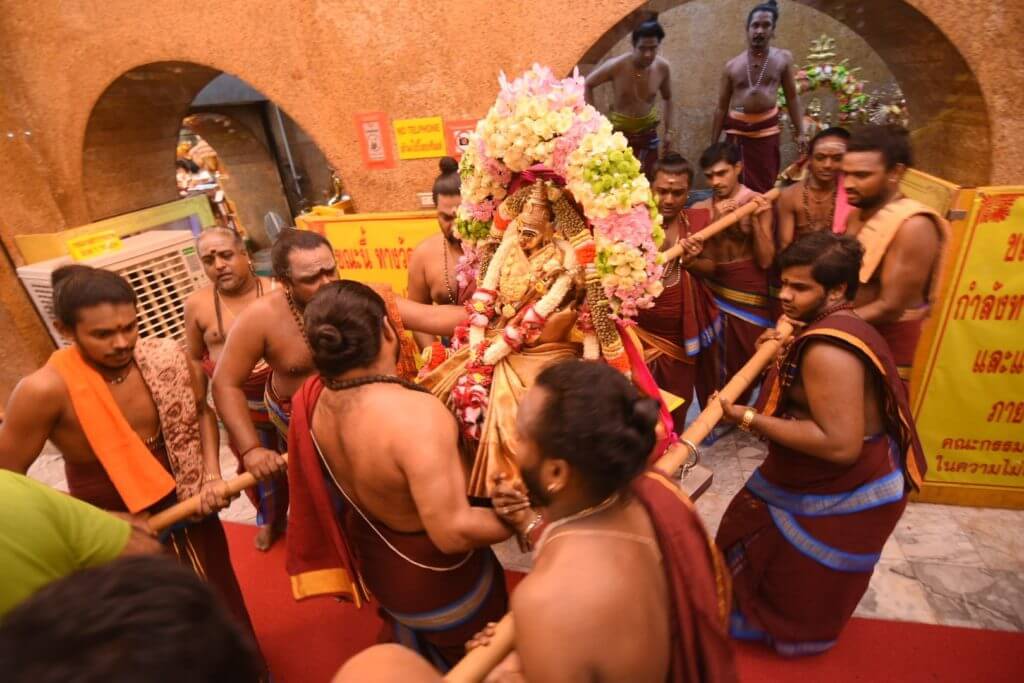
(cr. Matichon)
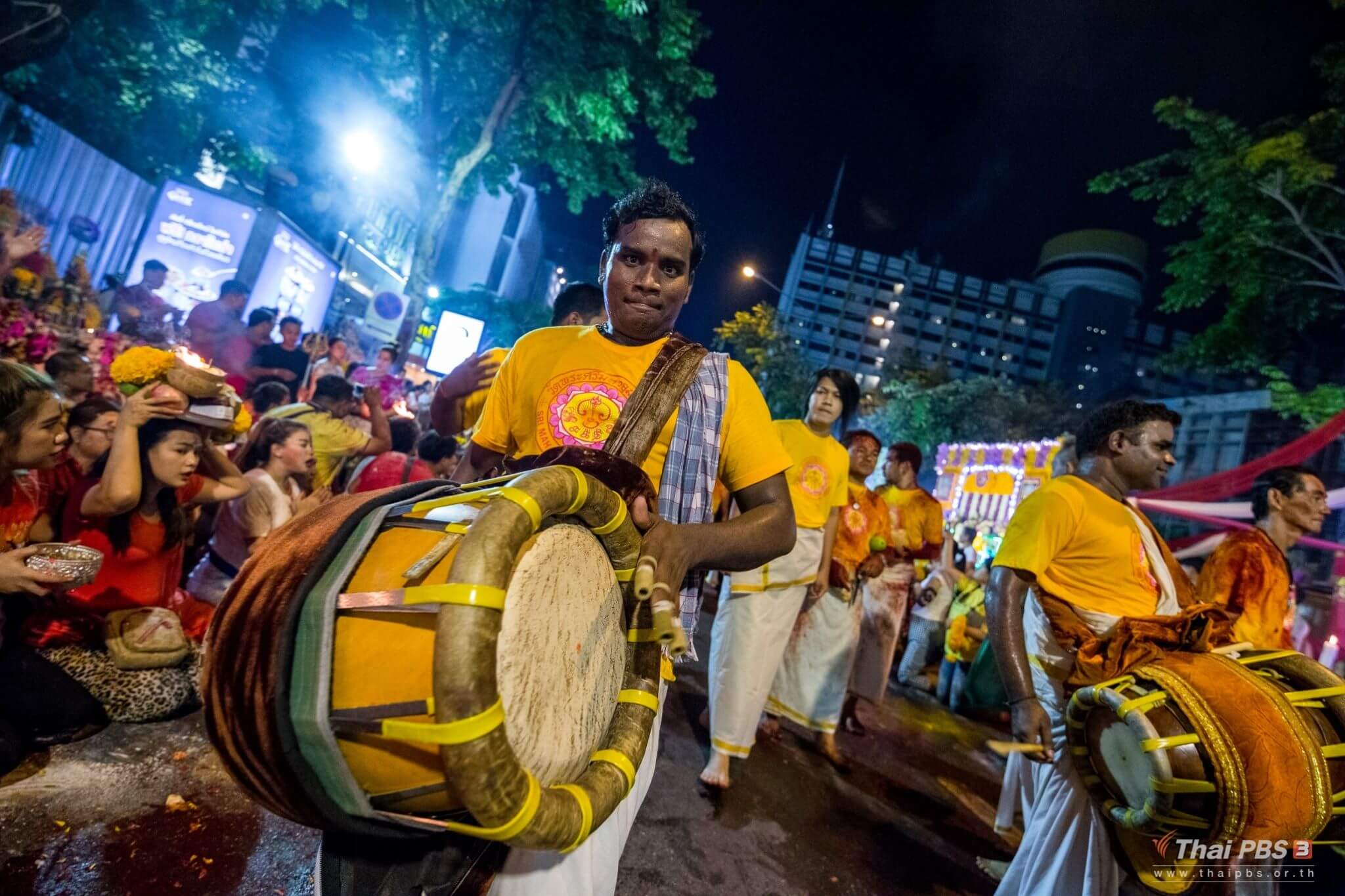
(cr. ThaiPBS)
Festival days: The main activities, which are to worship different avatars of Goddess Uma, and the procession will be organized in the following order:
- The lion flag is raised to the top of the pole to mark the beginning of Navaratri.
- The worship of Goddess Durga
- The worship of Goddess Lakshmi (goddess of fortune, fertility, wealth and money)
- The celebration of the marriage between Goddess Uma and Lord Shiva
- The worship of Lord Shiva
- The worship of Goddess Saraswati (goddess of knowledge, music, art, speech, wisdom, and learning)
- The Vijaya Dasmi Day procession, starting from the Sri Maha Mariamman Temple
- The lion flag is lowered, marking the end of the festival. Later in the evening, the Brahmins and the mediums will observe the Yellow Water Festival, and attendees may ask for holy threads to be tied around their wrists.
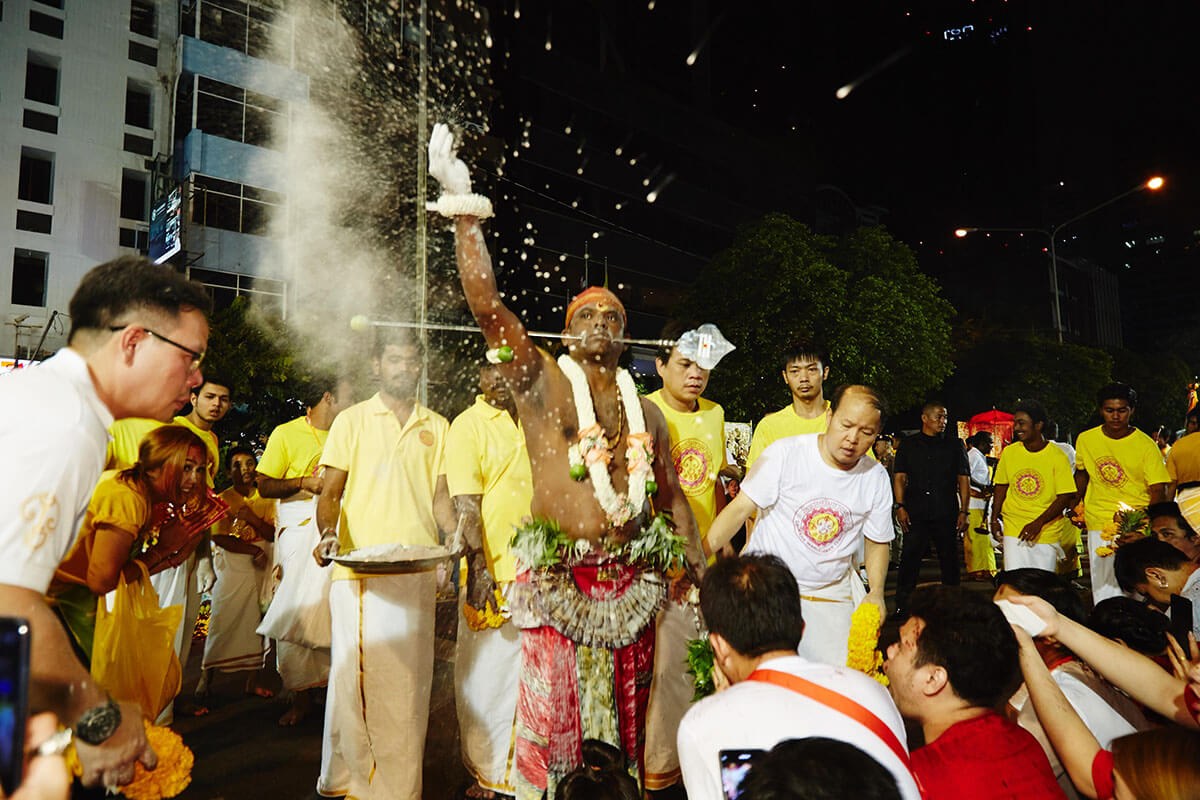
Medium blesses devotees (cr. The Momentum)
In addition to the rituals of worshiping the gods and the procession, the public can also visit the Sri Maha Mariamman Temple to make merit and pray to Hindu deities. That is to say, if you are going to make merit at the temple, you should dress in white, or wear an Indian sari. It is forbidden to bring meat of any kind into the temple. Offerings can only include milk, fruit, Indian sweets made from milk and sugar, and flowers, mostly yellow and red flowers, such as marigolds and roses. You may say a prayer in front of each of the idol if you wish. You may make a wish to the deities; however, you may simply ask the deities, but do not bribe them. Do not make any promise to the deities that if your wish comes true, you will offer them certain things in return.
Upon leaving the temple after you have paid homage to the deities, you will be anointed with a dot of red color on your forehead to show that you have been blessed by the deities. For Buddhists, remember to pay respect to the Buddha image in the temple before leaving.
People living along the parade route may set a little table at home to worship Hindu deities and to receive blessings from the procession of Goddess Uma. Even if you are far away and unable to attend the ceremony at the temple, you can also invite Goddess Uma to your home so that she can bless you and your family as well.
Values
This is yet another occasion that boasts cultural diversity that coexists harmoniously in Thai society. In September alone, we witness least three religious activities taking place in parallel (the Chinese Vegetarian Festival, Thai Festival of the Dead, and Indian Navaratri). Indistinguishably blended with the unique charm of each festival are the Thai elements and the sincere respect for the gods and fellow human beings, which forms such a strong and sturdy fabric of Thai society, withstanding any conflicts and mistrust.
Navaratri and the Sri Maha Mariamman Temple are part of the Indian culture, but interestingly, a Buddha image is enshrined as an essential element of the temple. At the same time, Thai people do not discriminate or suppress the freedom of belief of their Thai Indian brothers and sisters resulting in the thriving Indian culture in Thailand, the legacy, and beautiful religious activities that take place every year. Not to mention the Chinese element in the form of the Kau Chim fortune teller sticks inside the temple! The Thais respect the deities of different beliefs indiscriminately and discard the idea of superiority or inferiority.
More importantly, the Thais also learn to have fun with respect. Thais love festivals and celebrations but, at the same time, they take care to observe the dress codes, prohibitions, and regulations of different cultures with open arms. With this openness, Thailand has become a loving home to newcomers who are Thai Indians.
Despite the fact that this festival was originally celebrated only by Thai Indians, today we can see a beautiful diversity and unity of believers, whether Thai Buddhists or Thai Chinese, or Thai Indians, all rooted in the openness of the Thai society.
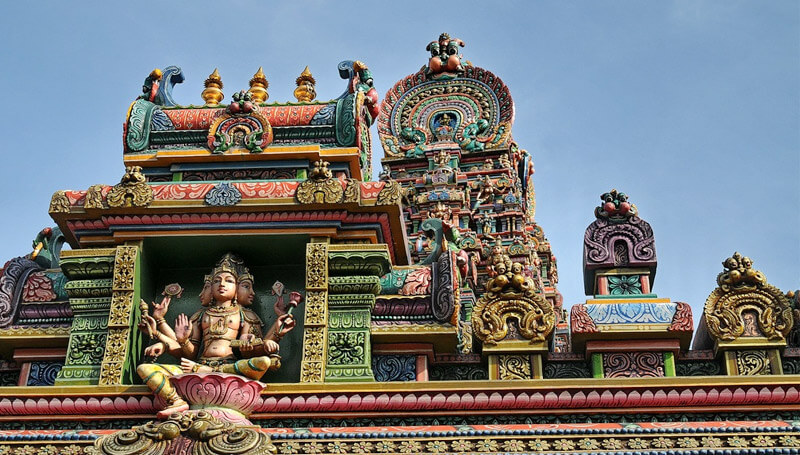
Sri Maha Mariamman Temple, Bangkok (MThai)
Sources
- https://travel.mthai.com/blog/91583.html
- https://www.thairath.co.th/lifestyle/woman/749491
- https://mekhanews.com/variety/give-away-navaratri-festival-calendar-2022/
Author: Sunyata Mialamai
Editor: Tayud Mongkolrat
October 2, 2022


